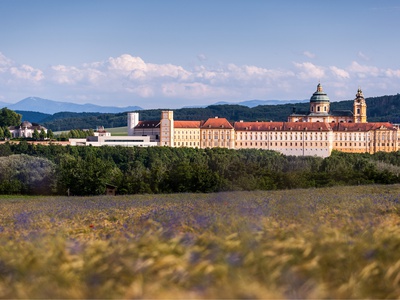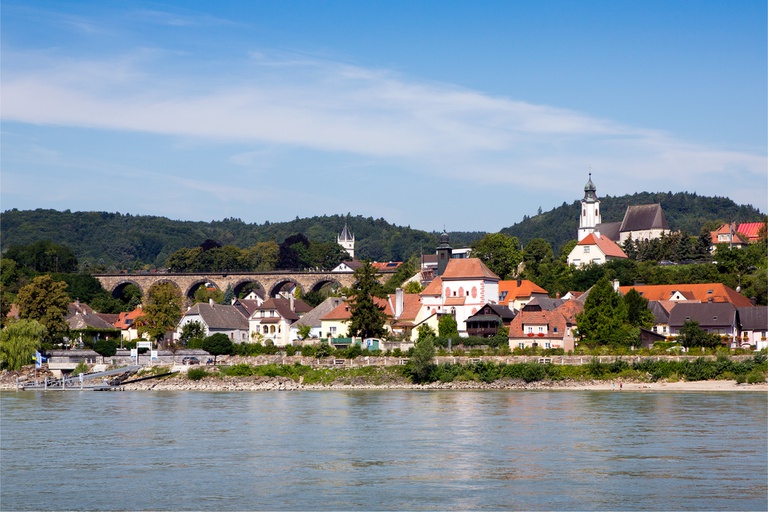Cultural Heritage
Cultural Heritage

The Wachau, a wine growing area renowned throughout the world, begins just where the magnificent baroque Melk Abbey arises on the southern bank. In 2000, the Wachau was declared part of the UNESCO World heritage. The picturesque river valley, in its entirety, extends up to the city of Krems 40 km Downstream.
The Wachau lies on the border of two Lower Austrian landscapes, Mostviertel to the south and Waldviertel to the north. The landscape is a combination of the river and near-shore areas with favourable climate and the adjacent hills of the Waldviertel region (altitudes up to 900 m) with cold winters. These climate conditions favor fruit production, like the famous Wachau apricot, and wine growing where the sunny days and cool nights are a prerequisite for high-quality wine. Some of the famous wines in the Wachau are the Riesling and the Grüne Veltliner. These and more specialities one can taste at numerous 'Heurige' restaurants, or wine growers.
Water has the power to attract, inspire, fascinate, refresh and give life. One can enjoy the charms of the valley on a ship cruise along the Danube. Dreams of a relaxing and pleasurable holiday can be realized anew, everyday, in the Danube district of Wachau-Nibelungengau. There are splendid castles and forts, interesting museums and culture parks, as well as the bewitching landscape which invite you to various activities, or just laze About. Traces of the rich heritage are visible at several locations: such as fertility statues dating back to primitive times, or solid walls from the Roman era. Or forts from the middle ages and conglomerations of cities, baroque churches, world-class castles and foundations: such as the Abbey of Melk, Göttweig Abbey or the little town of Dürnstein, to name just a few.
The Danube cycling track is perhaps one of the best known and most popular ones in Europe. Coursing through cycle paths and streets that are seldom driven on, this track goes close to the Danube along a stretch of 260 km, in Lower Austria.
Wachau Landmarks

Melk Abbey »The great cultural ensemble of Europe«.
Being a big spiritual and cultural center for more than 1 000 years, the abbey is one of the famous works of the Baroque builder Jakob Prandtauer. Its terraces, imperial staircases, inner courtyard und ceremonial rooms can be visited on a guided tour throughout the whole year. The Abbey park and garden pavilion are open for tourists from May to October.
More information about Melk Abbey
Göttweig Abbey
While the western part of the Wachau valley is famous for the Abbey of Melk, another Baroque landmark - the Göttweig Abbey - is situated to the East. The Benedictine monastery was literally a place of encounters - guests who came unannounced were something usual for the monastery.
More information about Göttweig Abbey
Castle ruins Aggstein
In one of the most famous medieval castles in Austria one can experience the everyday life of the knights via a guided tour that leads over hidden staircases and courtyards, past towers and to the dungeon.
More information about the ruins of Aggstein
Close to the Wachau you will find …
Artstetten Castle
The castle was once an estate and summer residence of the royal family, and later on the final resting place of the successor to the throne Archduke Franz Ferdinand und and his wife who fell victims to the Sarajevo attack at the beginning of World War I. Nowadays, it is a home of the permanent exhibition "For Heart and Crown" - telling the truly diverse story of the castle.
Wachau – Hiking

Discover the picturesque paths and trails going through vineyards, fruit gardents, and rocky landscapes along the Danube! Whether climbing or just walking, you will enjoy a lot of wonderful views of the Danube valley.
Here are a couple of selected routes showing the multitude of faces of the Wachau. Please refer to the receptionist team at Hotel »Zum Schwarzen Bären« for more hiking ideas.
Wachau World Heritage Trail – Views and impressions
The 180 km long trail goes all along the Wachau valley.

© Robert Herbst
Enjoy the Wachau World Heritage Trail in 14 stages following the unique stories and impressive past of the valley.
Apricot Trail – Immerse yourself into a world of colours and tastes
4,5 km long route through apricot gardens

© Weinhof Aufreiter
The Wachau Apricot Trail leads you though picturesque vineyards and apricot gardens to discover old Austrian traditions!
Vogelbergsteig
Fixed rope route 3.83 km, category A – Ending point Dürnstein

© Petra Mayerhofer
In a couple of minutes you can enjoy a mesmerising view of the Danube!
Wachau – Experience

Experience the Wachau valley on a bike tour, on a ship cruise, travelling by train or even on a segway.
Experience Danube Cycling Route
One of the most famous bike trails in Austria goes through Emmersdorf.

© Donau Niederösterreich Tourismus GmbH
The trail is extremely well signposted, going along the Danube close to the banks of the river with only a few meters of elevation. The best part - you can take the ship or train on the way back to the hotel!
Wachau Ship Cruises
Enjoy the Wachau valley travelling by water …

… on board of the MS Wachau, MS Prinz Eugen or MS Austria. There is a ship station in Emmersdorf as well! Alongside the scheduled trips you will find many themed cruises.
Wachau Bahn
The famous historic train goes from Krems to Emmersdorf through picturesque vineyards and views at Danube.

© weinfranz.at
Segways, E-bikes & Scooters
The Wachau is increasingly mobile today.
There is also an E-Station in Emmersdorf!
Wachau - Wine

The Vinea Wachau (Vinea Wachau Nobilis Districtus) is the association of winemakers in the Wachau area. It has three registered wine trademarks: Steinfeder, Federspiel, and Smaragd.
All three varieties are dry high-quality wines with no added sugar and, of course, with official state test number.
Steinfeder – Federspiel – Smaragd … You will find them only in the Wachau.
STEINFEDER …
… is the »lightest wine« with alcoholic content of up to 11% by volume. In comparison, Steinfeder and Federspiel are »extra dry«, and have maximum 4 g/l sugar residues. Their names come from the feather-light gras that grows on the steep slopes of the Wachau hills and and is under natural protection.
FEDERSPIEL …
… has medium full body with alcoholic content from 11 to 12.5 Vol.% and variation from plus-minus 0.5 Vol. % in the produced wine. At wine auctions, it follows the famous Smaragd.
The name's origin can be traced back to the times of falconry when birds of prey have been used for hunting.
SMARAGD …
… designates the best quality wines from the Wachau region. The alcoholic content starts from 12.5 Vol. % to and above 14 and the wine is »dry« with maximum 9 g/l sugar residues.
The name comes from the emerald-colored liyards that can be found in the Wachau vineyards.




